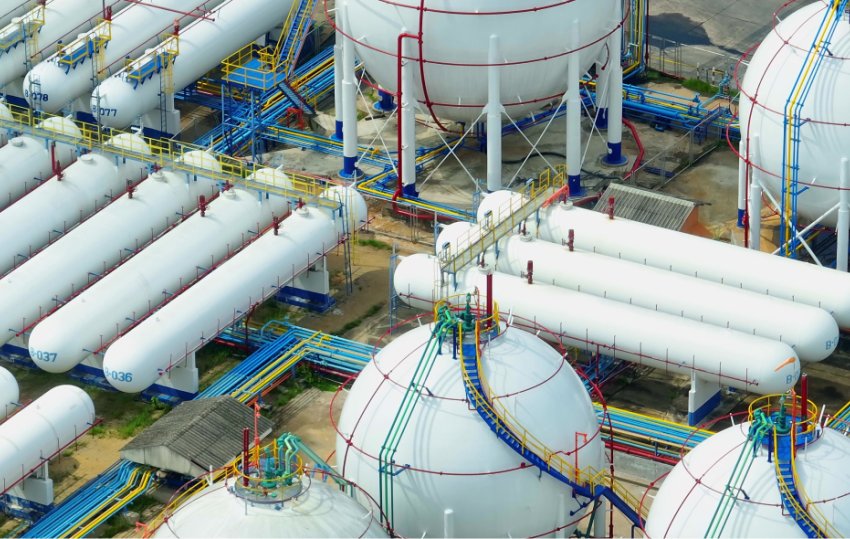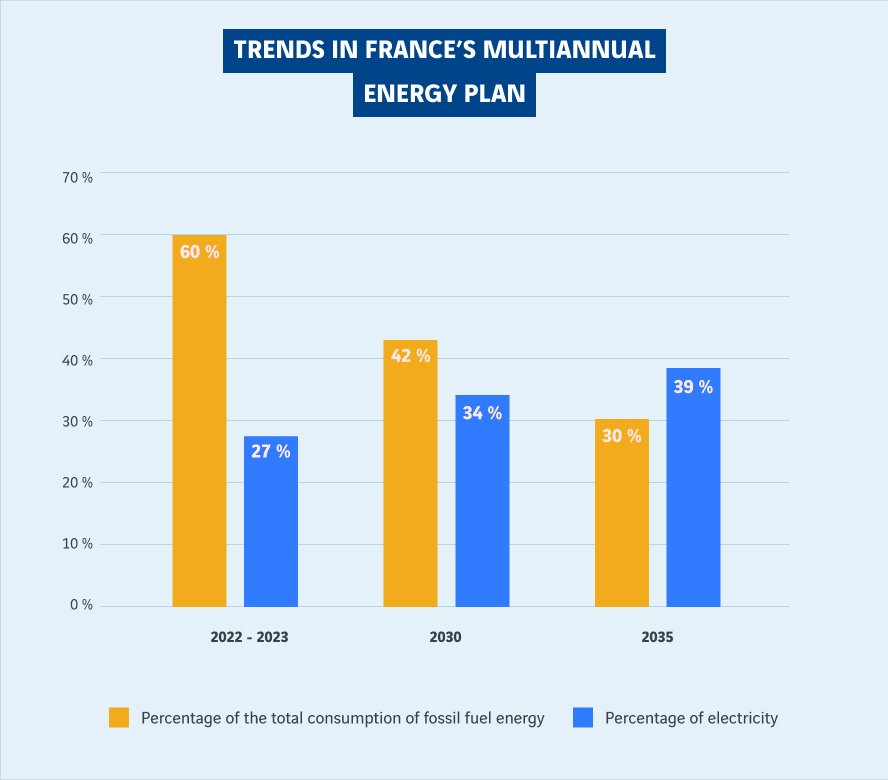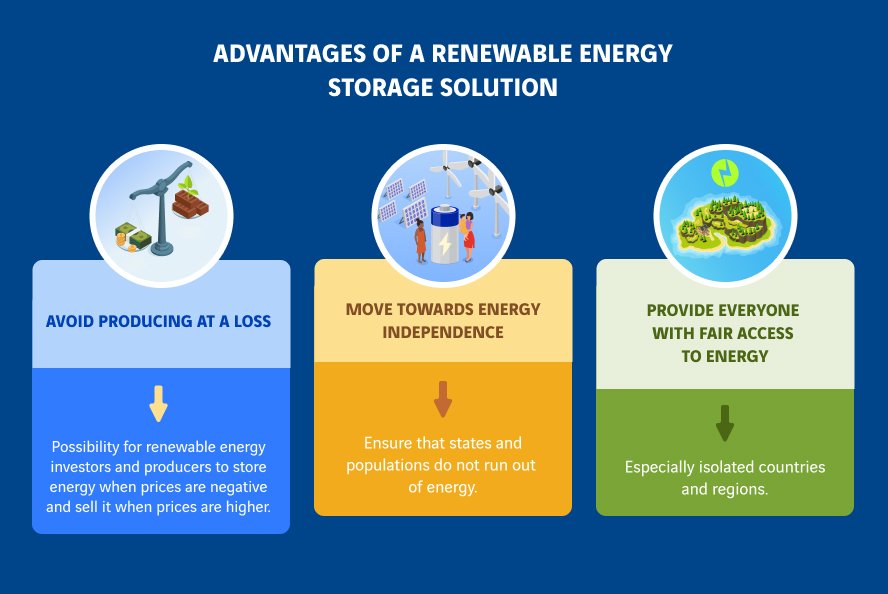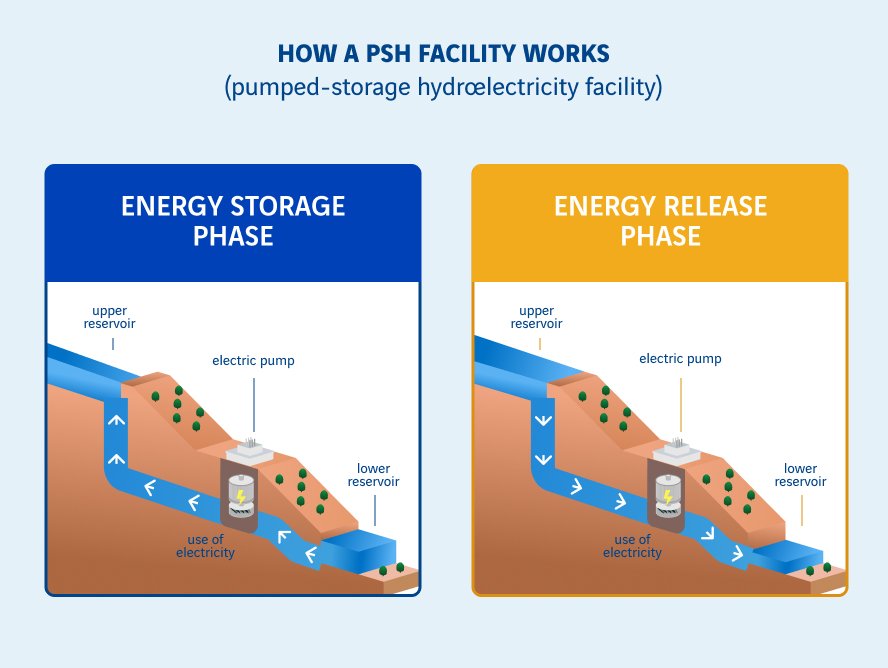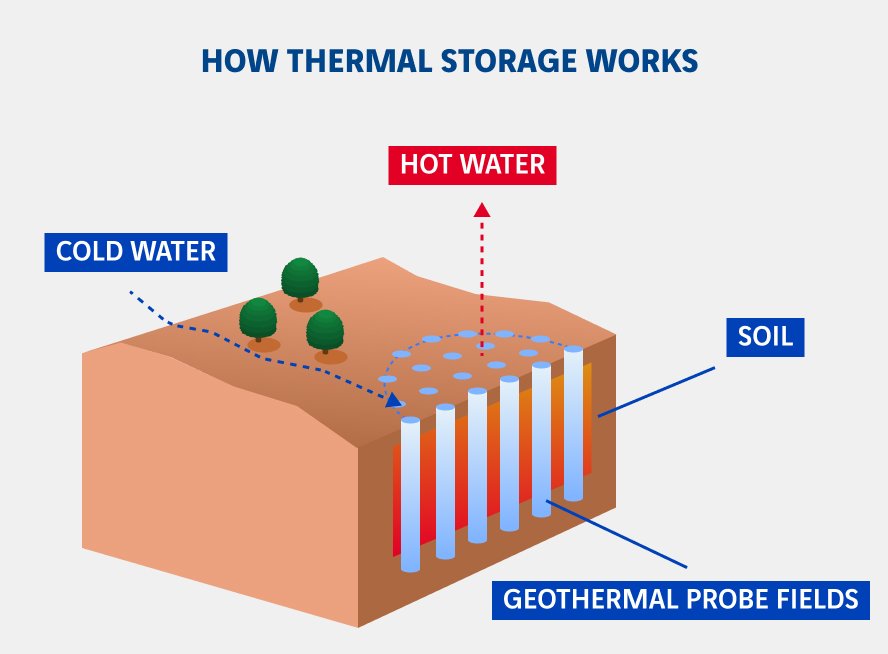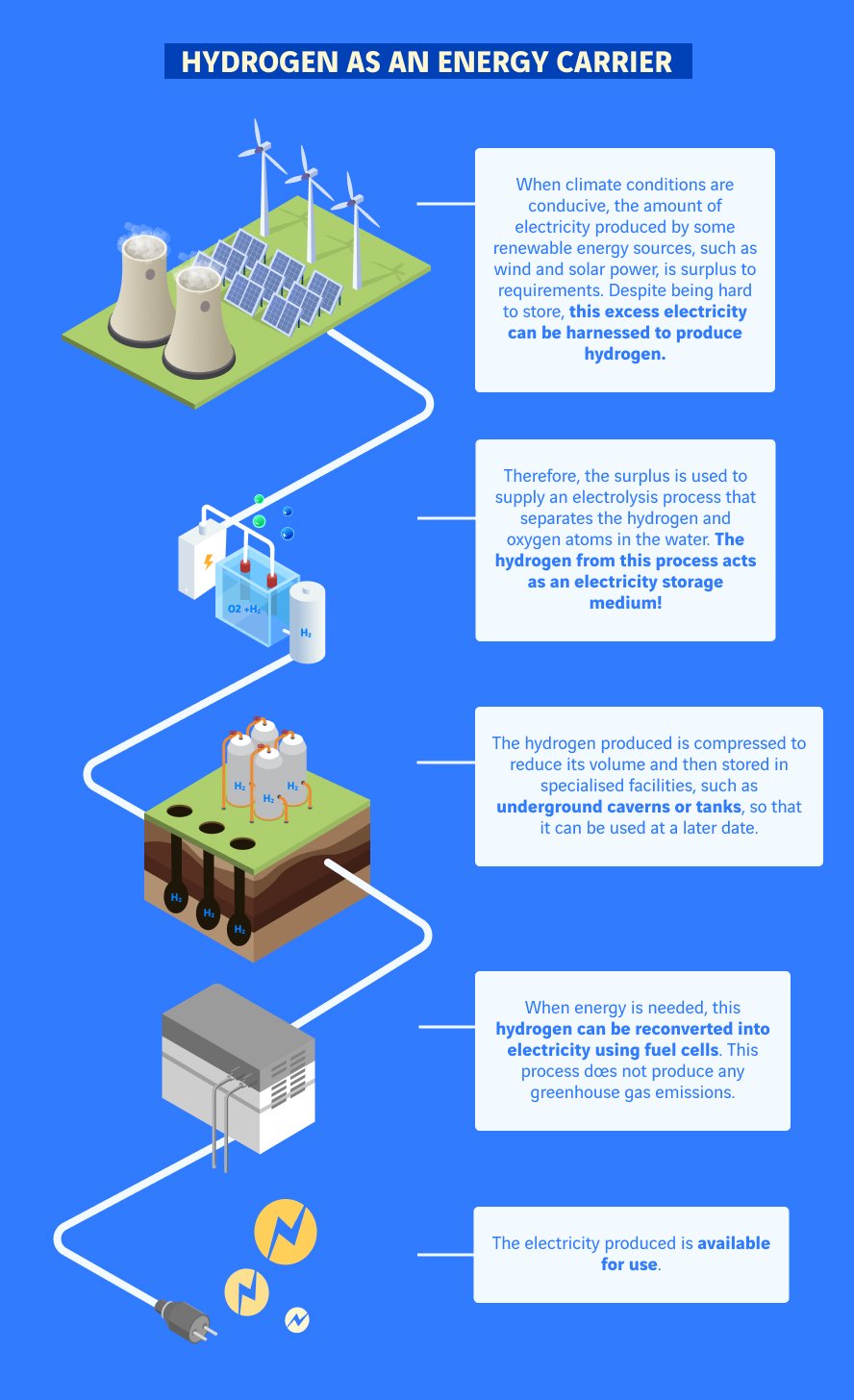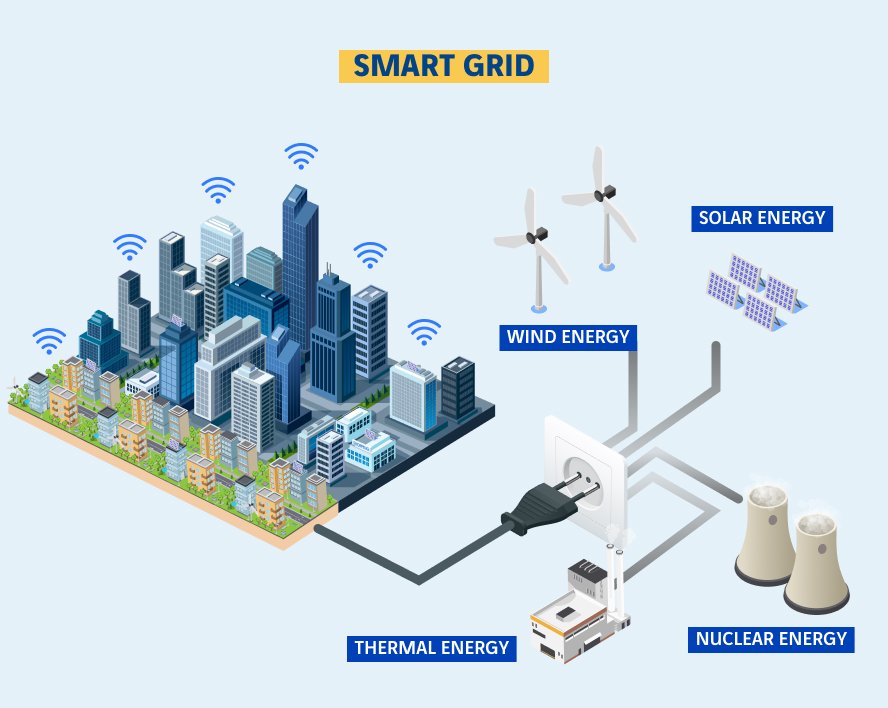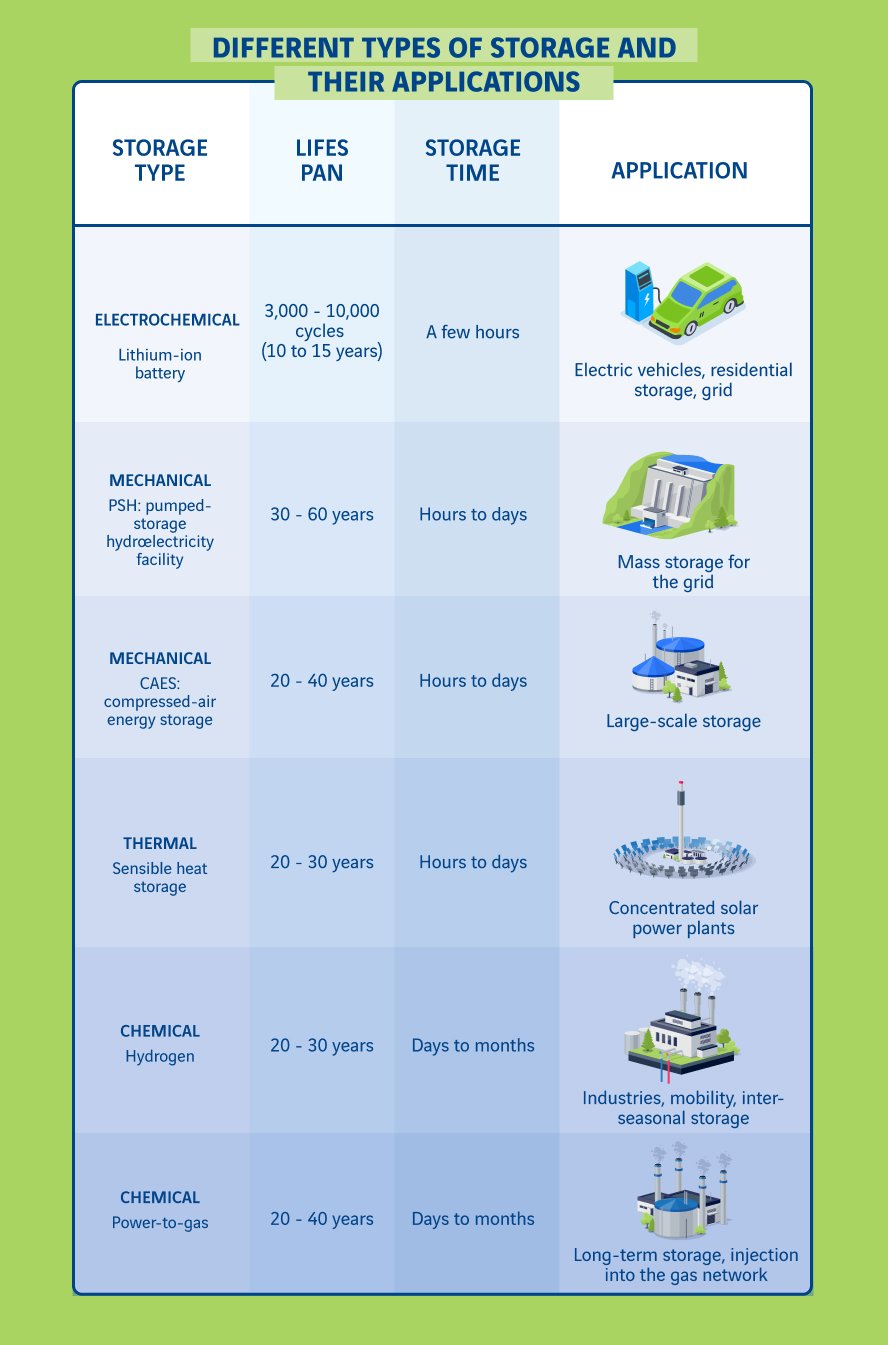Storage: the cornerstone for developing renewable energy
Combining renewable energy production with storage facilities is key to guaranteeing a greener energy mix offering greater stability and security. Storage technologies might still be in the developmental stages, but they are showing plenty of promise.
In the same report
Many states and regions are actively looking to scale down their greenhouse gas emissions. In particular, the European Union is aiming to reduce its CO2 emissions by at least 55% by 2030 through the “Fit for 55” package of proposals adopted in 2023 and thereby set the EU on the path to carbon neutrality by 2050.
Embracing electrification is essential for achieving this target. In France, the Multiannual Energy Plan (PPE) is designed to cut the total consumption of fossil fuel energy to 42% by 2030 and 30% by 2035. Electricity accounted for 27% of the country’s energy use in 2023 and is set to rise to 34% in 2030 and 39% in 2035. In particular, the country is expected to generate an extra 19.5 GW of power from wind energy by 2035, with 1.5 GW from onshore wind and 18 GW from offshore wind.
The role played by storage in developing renewable energy
This situation explains why countries everywhere are scrambling to build new renewable energy (RE) facilities. In 2024, Germany added 20 GW of renewable energy production capacity to its national energy mix, led by solar power (+16 GW). It is a similar story in France, where 6.7 GW of renewable electricity have been added, with 5 GW from solar power. The trend will continue in 2025.
However, unless storage solutions are available, intermittent renewable energy (RE) can be lost when production occasionally outstrips demand. For example, if the amount of solar energy produced during sunlight hours exceeds the level of demand, the surplus cannot be used at night.
To avoid producing at a loss during periods when supply is greater than demand, some facilities need to interrupt or scale back their power generation. France’s national grid operator (RTE) is encouraging regional distributors to level off their production, especially by introducing zero or negative feed-in tariffs. In 2024, “the amount of wind and solar power production that was curtailed represented around 1.7 TWh, i.e. 2.4% of the cumulative wind and solar power production over the year”. Similarly, the European Commission in Brussels recorded some 4,166 hours during which electricity prices throughout Northern Europe became negative in the spring of 2024.
The prospect of producing at a loss can slam the brakes on the development of renewable energy. By combining energy production with a storage solution, renewable energy producers and investors know that they can keep their energy during periods when prices are negative and sell it when prices climb to higher levels.
Storage: an asset for the economy and society
Using storage solutions to retain the energy generated allows producers, whether communities or large-scale networks, to achieve energy independence. At a time when the tensions running across the international scene are threatening long-standing oil and gas supplies, the prospect of independently producing green energy is attracting significant interest. The ability to store energy for a certain amount of time gives states and populations greater peace of mind that their supplies will not run out.
This is especially true for isolated areas. In some cases, they cannot rely on interconnectors hooked into the power grid to satisfy their energy needs due to geographical reasons, such as islands far from the coast, or communities at altitude or in areas subject to extreme climate conditions (high mountains, deserts, polar or arctic zones, etc.). This means that storage solutions have an even more critical role to play.
Devising solutions for producing and storing energy in isolated areas is one way of providing everyone with fair access to energy and helping developing countries grow their own energy infrastructure.
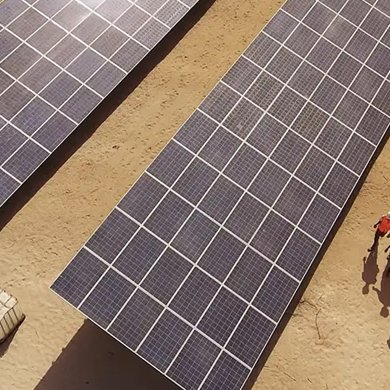
For example, in Senegal and Burkina Faso, VINCI Energies subsidiary Omexom is rolling out solar power plants with integrated battery energy storage systems.
In a continent where several inhabitants are not connected to the power grid, independent mini-grids featuring an energy mix with a large proportion of solar and wind power are solutions for the future. These installations represent an alternative to the central grid, which often lies far beyond their reach.
The UK grid operator National Grid estimates that battery storage systems could save the country up to $48 billion by 2050.
Four storage solutions for… renewable energy
Electrochemical storage
The most widespread example of a large-scale energy storage system in the world is electrochemical energy storage using batteries, especially lithium-ion batteries. This is the same type of battery used in mobile phones and electric vehicles.
This type of storage system is ideally suited to the needs of short-term networks, since the batteries charge and discharge quickly, together with an excellent efficiency rate (85 to 95%). In addition, these systems can easily be set up close to where the energy will be used. However, their lifespan is currently limited to between 10 and 15 years (or even 3 to 5 years in the case of intensive use), and their initial cost is still relatively high. But this situation should gradually change, since costs are already expected to fall by 11% in 2025.
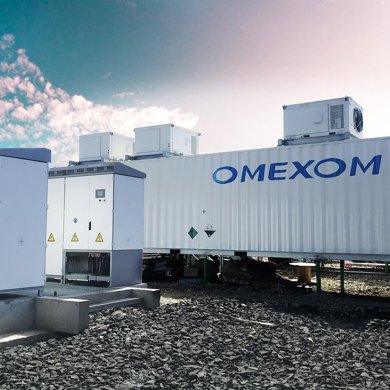
Omexom Conversion & Storage (VINCI Energies) actually built France’s largest battery energy storage facility in Dunkirk (northern France) on behalf of TotalEnergies.
With a storage capacity of 61 MW / 61 MWh when it was developed, it was one of the most powerful systems in mainland France.
New-generation batteries under development
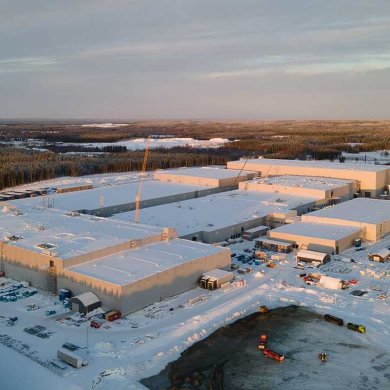
Several projects are currently in the pipeline to manufacture batteries that are kinder to the environment. For example, the Northvolt Ett plant built in Sweden back in 2018, which involved several VINCI Energies companies, aims to produce the world’s greenest batteries. In addition to basing the production process for its batteries on a fully renewable energy source, the site is also planning to recycle them with the first large-scale battery recycling plant in Europe.
Researchers are also making headway as part of their efforts to extend the life of lithium-ion batteries and thereby make them more economically appealing and more virtuous in ecological terms.
Other research is also being carried out to produce batteries that are smaller, cheaper or lithium-free. Companies are working on developing solid-state batteries, which will be lighter, longer lasting, safer and more efficient. Batteries using sodium, which is a less costly and more abundant alternative to lithium, are also starting to gain traction, particularly in China, where a 100 MWh project was inaugurated in June 2024 in the province of Hubei.
Mechanical storage
Pumped-storage hydroelectricity (PSH) facilities were created in Switzerland at the end of the 19th century. These hydroelectric plants can be used to create or store energy on demand. When the water in the upper reservoir is released into the lower reservoir, electricity is generated by the water driving a turbine. This system is activated in response to an increase in energy demand. On the other hand, when energy is in plentiful supply, water is electrically pumped to the upper reservoir, so in a way, the energy is stored for later.
The whole point of a PSH is to smooth out consumption, because pumping water actually uses more electricity than what the turbines produce. Therefore, PSH stations act like real energy management systems. This type of solid, durable facility requires specific geographical sites, with two reservoirs located at different altitudes.
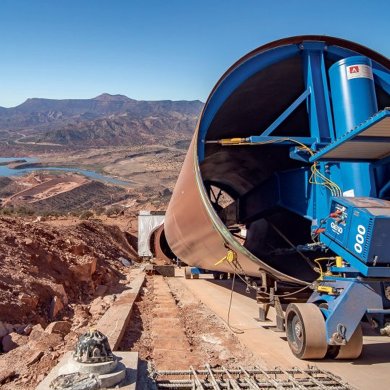
In Morocco, VINCI Construction has built a pumped-storage hydroelectric plant close to the Abdelmoumen dam near Agadir. The site was chosen for its mountainous terrain. Both reservoirs are separated by a height difference of 600 m and can hold 1.3 million cu. metres of water, which flows down 14 km of pipes when the need for electricity arises. The plant’s two turbines each produce 175 MW.
Mechanical storage also includes CAES (compressed-air energy storage), which involves capturing and compressing ambient air to very high pressure so that it can be stored. Decompressing the gas in a turbine generates energy. Research is underway to develop a more efficient technology.
Thermal storage
The heat generated by concentrated solar power plants or biomass boilers can be stored for a relatively long time in a hot water storage tank, which is used directly to supply a network for homes (heating or domestic hot water).
Researchers are looking at ways of combining this system with geothermal energy. By burying the tank underground, the high temperatures can be maintained for a longer period of time. Soon, the heat accumulated during the summer could be used to heat homes in the winter.
Gas-based chemical storage (hydrogen)
Using hydrogen to store energy is still in the research stages. The idea is to store the surplus energy produced by a renewable energy site as gas, which can then be converted back into electricity when required (gas-to-power). Basically, if too much renewable energy is produced, instead of going to waste, it is harnessed to produce green hydrogen gas from the electrolysis of water (a process that separates water (H2O) into oxygen (O) and hydrogen (H2) using an electric current). This gas can be transported and stored. When production falls or demand surges, the stored hydrogen can be converted back into electricity using a generator.
Hydrogen could be an effective way of storing energy for long periods of time and transporting it to where it is needed (see table below). VINCI has actually set up a specific focus group for green hydrogen within Leonard, its foresight and innovation platform. The Group is also one of the 30 manufacturers that launched HyDeal Ambition in 2021 to lay the foundations for the future European hydrogen industry, which will produce carbon-free hydrogen at a cost competitive with fossil fuels.
VINCI Construction subsidiary, Geostock is already offering an underground storage service for carbon-free hydrogen at several European sites through the Hystories project.
For the time being, however, many obstacles still need to be overcome, especially the cost of producing green hydrogen, which is much higher than grey hydrogen (i.e. generated from non-renewable energy sources), and the energy losses that occur when transforming energy into gas and gas into energy. Research efforts are continuing in an effort to limit these losses. Whether in Europe, North America or China, the number of projects is rising, which bears testament to the proactive determination to come up with long-term solutions.
Striking a balance between production and demand
However much energy is used, every country faces the challenge of producing enough power to fulfil its needs. Since most renewable energy sources are intermittent, storage solutions are being developed and are proving to be profitable.
For example, there are 2,469 active and inactive energy storage projects in the UK. Storage capacities reaching 4.7 GW have already been installed, and revenue from the battery balancing mechanism attained a record-breaking £27k/MW/year in February 2025. Poland is another country that is clearly making headway in this sector. The country ramped up its storage capacity from 165 MW in 2022 to 2.5 GW in 2024.
Grid operators are using such tools as smart grids to harmonise energy supplies, whether from renewable or non-renewable sources. The process involves centralising data and then intelligently analysing that information to anticipate future energy demand and adapt storage capacities accordingly. Operators can achieve this aim by applying artificial intelligence algorithms to energy storage. Their use not only improves energy efficiency, but also greatly reduces costs.
This holistic approach intelligently combines different existing renewable energy technologies with smart management strategies and various storage techniques to improve efficiency.
Resources and challenges for energy storage methods and tools
As with any type of facility, storage involves the use of natural resources, which may sometimes be scarce, and host sites that can be difficult to secure, depending on the region of the world. Li-ion batteries use lithium, cobalt, nickel, and so on, which are considered to be critical resources and whose geographical origin is restricted to certain countries. Although reserves currently appear to be in sufficient supply, demand is soaring while extraction capacities are still in the slow lane, meaning that resources must be used in a responsible manner.
Therefore, it is important to accurately examine the benefits and relevance of storage facilities in the long term and throughout their lifecycle.
Lifespan, storage time…
Sources :
Fit for 55 : adoption des nouveaux objectifs climat-énergie européens pour 2030. https://www.horizon-europe.gouv.fr/fit-55-adoption-des-nouveaux-objectifs-climat-energie-europeens-pour-2030-36213
France Nation Verte – planifier une France décarbonée. https://www.consultations-publiques.developpement-durable.gouv.fr/IMG/pdf/01__document_synthetique_presentation_ppe.pdf
Enerdata – « Germany added nearly 20 GW of renewable power capacity in 2024 ». https://www.enerdata.net/publications/daily-energy-news/germany-added-nearly-20-gw-renewable-power-capacity-2024.html
Enedis – « Les énergies renouvelables ont couvert 33,9 % de la consommation d’électricité de la France en 2024 ». https://www.enedis.fr/presse/les-energies-renouvelables-ont-couvert-339-de-la-consommation-delectricite-de-la-france-en
RTE – Bilan électrique 2024 – « Les écrêtements de la production éolienne et solaire ont été plus importants en 2024 que dans le passé ». https://analysesetdonnees.rte-france.com/bilan-electrique-2024/production#Ecretementsdesproductionseoliennesetsolaires
L’Opinion – « L’Europe accumule les heures d’électricité à prix négatif ». https://www.lopinion.fr/economie/leurope-accumule-les-heures-delectricite-a-prix-negatif
The Agility Effect - “Off-grid systems can accelerate country electrification”. https://www.theagilityeffect.com/en/article/off-grid-systems-can-accelerate-country-electrification/
National Grid - “What is battery storage?“. https://www-nationalgrid-com.translate.goog/stories/energy-explained/what-is-battery-storage?_x_tr_sl=en&_x_tr_tl=fr&_x_tr_hl=fr&_x_tr_pto=rq
BloombergNEF - “Global Cost of Renewables to Continue Falling in 2025”. https://about.bnef.com/insights/clean-energy/global-cost-of-renewables-to-continue-falling-in-2025-as-china-extends-manufacturing-lead-bloombergnef/
The Agility Effect - “How Omexom is contributing to electricity grid regulation”. https://www.theagilityeffect.com/en/article/how-omexom-is-contributing-to-electricity-grid-regulation/
Connaissance des énergies – « STEP : stations de transfert d’énergie par pompage ». https://www.connaissancedesenergies.org/fiche-pedagogique/hydroelectricite-stations-de-transfert-denergie-par-pompage-step
eMag VINCI – “How to store electric energy - PSPs”. https://www.vinci.com/en/emag/how-store-electric-energy-psps
Connaissance des énergies – « CAES : stockage par air comprimé ». https://www.connaissancedesenergies.org/fiche-pedagogique/caes-stockage-par-air-comprime
Observatoire des transitions énergétiques 2025 – De Gaulle Fleurance. https://www.degaullefleurance.com/wp-content/uploads/2025-06-03-observatoire-transitions-energetiques-2025-vf.pdf
France Renouvelables – « Comment optimiser les systèmes de stockage d’énergie ? ». https://www.france-renouvelables.fr/guide-stockage-energie/stockage-energie-comment-optimiser-systemes/
France Renouvelables – « Tout savoir sur le stockage d’énergie ». https://www.france-renouvelables.fr/guide-stockage-energie/stockage-energie-guide-complet-solutions-astuces/
Global Energy - “Lithium demand to grow fivefold by 2040 (...)”. https://globalenergyprize.org/en/2025/05/30/lithium-demand-to-grow-fivefold-by-2040-with-cobalt-demand-rising-by-one-and-half-times/
VINCI Energies - “Northvolt Ett, a factory dedicated to producing greener batteries”. https://www.vinci-energies.com/en/project/northvolt-ett-a-factory-dedicated-to-producing-greener-batteries/
L’Echo – « Northvolt, le joker européen dans la course mondiale à la batterie la plus verte ». https://www.lecho.be/entreprises/industries-de-base/northvolt-le-joker-europeen-dans-la-course-mondiale-a-la-batterie-la-plus-verte/10538154.html
Saft - “Solid-State Program”. https://saft.com/en/solid-state-program
CNEVPOST – « “World’s largest” sodium-ion battery energy storage project goes into operation in China ». https://cnevpost.com/2024/07/02/world-largest-sodium-battery-energy-storage-project-in-operation/?utm_source=chatgpt.com
Subscribe
Stay tuned : receive our newsletter
Every quarter, discover new articles, exclusive features and experts' views delivered straight to your inbox.
Most viewed
Explore more
Marina Lévy - Companies at the heart of ocean conservation issues
Marina Lévy, oceanographer, research director at the CNRS and ocean advisor to the president of the French National Research…
Building with and for nature
Whether creating barrages, stripping away topsoil, cutting down trees or digging channels, humans have spent thousands of…
Bridging the construction gender gap: paving the way to a career in industry for women in Colombia
In 2025, the Ruta 40 consortium led by VINCI Construction Grands Projets completed work on widening and upgrading the Bogotá…
